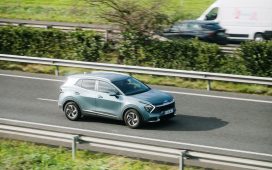The Malaise Era is often considered to have concluded in 1983 with the introduction of a 175-horsepower V8 in the Fox-body Mustang, although 175 ponies from a 4.9-liter carbureted engine doesn’t really scream performance by the standards of the 1960s and late 1980s. Quality and reliability were a big problem for American manufacturers as well, which is why consumer preference started to shift in favor of Japanese brands.
Given these circumstances, does it come as a surprise the Camry sold more than 13 million units in the United States alone since its launch in this part of the world? The quotation marks from earlier were used because Toyota’s very first Camry wasn’t a Camry, but a four-door variation of the Carina. The Celica Camry shared few components with the actual Celica, which rocked two-door coupe and three-door liftback options back then.
A40 and A50 Celica Camry (1979 to 1982)
Longer than the Carina despite featuring an identical wheelbase (98 inches or 2,500 millimeters), the first Camry of the bunch sold in excess of 100,000 units in Japan during its three-year production life. Assembled exclusively at the Tsutsumi plant in Aichi, the A40 and A50 series Celica Camry sports a slightly elongated Carina front end. It also incorporates design cues from the Celica XX, a.k.a. Celica Supra outside of Japan.
Customary of a vehicle designed in the latter part of the 1970s, all versions of the Celica Camry flaunt rear-wheel drive. As for the A40 and A50 designations, A40 stands for lesser models with a solid rear axle, whereas A50 denotes independent suspension for every corner.
Tipping the scales at just under a metric ton for the lightest configuration available, the Celica Camry that started the Camry lineage could be had with four-cylinder mills ranging from 1.6 to 2.0 liters. The Celica Camry isn’t considered a true Camry due to its relation to the Carina, which brings us to the V10 series.
V10 series (1982 to 1986)
Before going any further, any series beginning with V designates narrow-body models. Those with XV refer to wide-body models. Also worthy of note, Toyota’s first-gen Camry was also sold under the Vista nameplate at Toyota Vista Store locations. Also produced at Tsutsumi in Aichi, the Vista slots above the Carina and Corona.
Adding to the confusion, diesel-powered models are referred to as CV10 and CV11 depending on displacement (1.8 and 2.0 liters, respectively). As opposed to the not-a-Camry Celica Camry, the Camry switched to a transverse powertrain layout and FWD.
Launched in the United States for the 1983 model year, the first-gen Camry was positioned against its long-running arch nemesis from Honda and quite a few American competitors. The most obvious are the K-car Chrysler lineup, Ford Tempo, and Chevrolet Citation.
V20 series (1986 to 1992)
Twinned with the first-generation Lexus ES, the V20-series Camry features a similar wheelbase to the V10. Longer, wider, and more spacious for both occupants and their luggage, the redesigned Camry combined the rectilinear profile of a conventional sedan with more rounded lines to make it a little bit more aerodynamic.
Following the four-door sedan and five-door liftback body styles of its predecessors, the V20 series welcomed the very first station wagon-bodied Camry of the lot. Also worthy of note, the V20 was the first Camry to be manufactured in the United States of America at the Japanese marque’s facility in Georgetown, Kentucky.
Another first rolled out with the V20 is All-Trac, a four-wheel-drive system introduced for 1988. This generation also introduced a Camry staple in the form of V6 power, coming in the guise of the 1VZ-FE and 2VZ-FE mills.
V30 (1990 to 1994) and XV10 (1991 to 1996)
The Camry surpassed the 100,000 sales mark stateside in 1985, which prompted Toyota to develop the wider-body XV series. The XV10 launched one year after the narrow-body V30, and given time, Toyota discontinued the V series altogether in favor of the wide-bodied XV.
V30 models were exclusive to Japan, and the reason Toyota built narrow- and wide-body variants of the Camry is rather simple. On the one hand, size regulations required a body width of 1.7 meters (5.6 feet) in Japan. On the other hand, American motorists are used to larger vehicles than their Asian and European counterparts.
As a result, the V30 measures 1,695 millimeters (66.7 inches) in width compared to 1,770 millimeters (69.7 inches) of the XV10. The Lexus ES from this era was offered as the Toyota Windom in the Land of the Rising Sun. Similar to the preceding V20, the flagship specification was marketed as the Camry Prominent.
V40 (1994 to 1998) and XV20 (1996 to 2002)
Not even an inch taller than its processor, the V40 doesn’t differ much from its predecessor due to the regulations mentioned earlier. The Prominent was discontinued with this generation, leaving the Vista as the range-topping specification. Four-cylinder lumps with displacements of 1.8 to 2.2 liters had to suffice.
The XV20, meanwhile, launched two years later with plenty of input from Toyota’s Ann Arbor-based engineering facility in Michigan. Two inches longer in wheelbase compared to the XV10, this generation of the Camry became the best-selling car in the U.S. of A.
Toyota Racing Development souped up the XV20 in 1997 with the introduction of a supercharger kit. Designed specifically for the 3.0-liter V6 engine, said blower squeezed out up to 247 horsepower and 242 pound-feet (328 Nm) of torque from the 1MZ-FE.
V50 (1998 to 2003) and XV30 (2001 to 2006)
Exclusively offered as the Vista, the Japan-only V50 is built around the MC front-wheel-drive platform introduced by the original Prius. The MC replaced both the Corolla’s E platform and larger T platform of the Corona, Carina, and Avensis in a bid to reduce costs.
The narrow-body Vista’s canning saw Toyota rebrand the Vista dealership network into Netz. The heir apparent of the sedan-bodied Vista and station wagon-bodied Vista Ardeo is the second-generation Toyota Avensis.
Longer and taller than the XV20, the XV30 for North America features the extremely versatile K platform introduced by the second-generation Avalon. Swoopier and comfier than ever before, the Camry from this generation topped 431,703 deliveries in the U.S. of A. back in 2005, its final full calendar year in production.
XV40 series (2006 to 2013)
Revealed with much pomp and circumstance in 2006 at the North American International Auto Show, the XV40 was also sold in Japan either as the Camry or Daihatsu Altis. It was joined by a premium-oriented sibling known as the Aurion, bearing the very same XV40 codename.
A rather predictable redesign compared to the XV30, the newcomer was peak Camry as far as popularity was concerned. Toyota sold a staggering 473,108 units in the 2007 calendar year in the United States of America, a number that truly boggles the mind in this day and age.
XV40 is also remembered for introducing the Hybrid Synergy Drive hybrid system to the Camry. It produces 187 horsepower, and under the EPA’s pre-2008 testing procedures, it promised a somewhat unbelievable 40 miles per gallon (5.9 liters per 100 kilometers) in city driving. Revised testing methods for the 2008 model year saw the hybrid’s rating drop to 33 mpg (7.1 l/100 km).
XV50 series (2011 to 2020)
Once again sold by Daihatsu as the Altis in Japan, the XV50 was received to lukewarm reception due to dull redesign and mostly carryover powertrains. Toyota did update its Hybrid Synergy Drive for this generation, which couldn’t be had with a manual gearbox stateside.
Slightly more angular, the XV50 also flaunts a restyled interior with Entune infotainment. The lukewarm reception from the public was exacerbated by the motoring press, which forced Toyota to redesign the Camry to a tremendous extent for the 2015 model year.
The U.S. and Japanese variants ended production in May 2017, although Vietnam kept making the seventh-gen Camry until August 2020. The most powerful engine offered was the 2GR-FE V6, a free-breathing mill rated at 268 ponies and 248 pound-feet (336 Nm) of torque.
XV70 series (2017 to present)
The current generation was introduced in January 2017 for the 2018 model year at the North American International Auto Show on the K version of the Toyota New Global Architecture series of modular platforms. In other words, it’s joined at the hip to the Crown, Venza, Highlander, RAV4, Sienna, Lexus ES, NX, and RX.
Much better styled than its predecessor, the XV70 was the first series-production Toyota to feature Linux-powered Entune 3.0 infotainment. Another highlight is the return of all-wheel drive to the list of options. Torque Control AWD adds 165 pounds (75 kilograms) compared to the front-wheel-drive equivalent. At the moment of writing, the 2023 model year Camry LE AWD can be yours for $27,620 sans freight charge.
Late 2023 will see the Camry discontinued back home in Japan due to dwindling sales, but elsewhere in the world, the understated yet brilliant sedan will see at least one more combustion-engined generation. It will likely borrow styling cues from the Crown and all-new Prius, along with Toyota’s latest-gen hybrid powertrains.




















